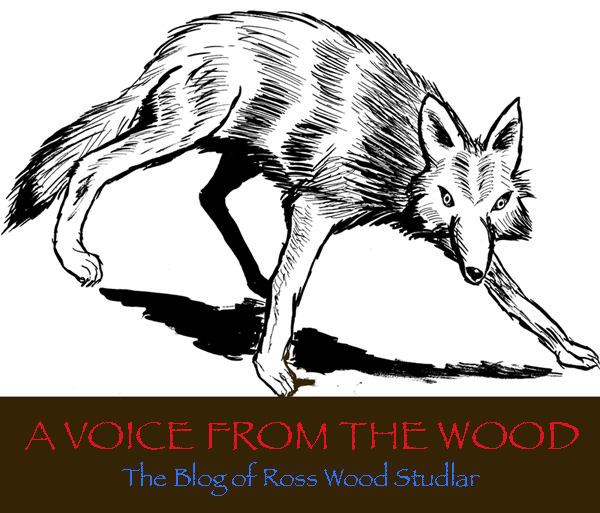 Ross and Cabin Bob at dusk
Ross and Cabin Bob at duskRecently, I revisited
The Homestead, for the first time since the reunion in 2007. It will always feel strange to use a computer at the Homie, but even so, in the quiet of evening, I took out my laptop and typed some reflections....
There are so many stories. In the walls, in the kitchen, by the fire circle, on the earth beneath my feet. Never before or since have I been so intimately connected to a piece of land as I was to here. Never before had I given such thought, care, sweat, and work to the development of a landscape. Now, a barrier of years has formed between me and this grand Homestead. She now wears gloves when she touches me. Even so, The Homestead is still a great friend, a love, an old home to return to.
I notice large stories and small ones. I see parts of buildings constructed by my own hands, and quotations on the walls written with my own felt-tip marker.
I see the tall sycamores and low brambles around the creek that runs before the main entrance, and recall a story. It was in the May Term of 2003, and a throng of summer Homesteaders were present. A torrential rain storm had just happened. The winds rocked the forests around us, and sent limbs crashing from trees. Entire trees fell over, in parts of town not far from us. But the walls of our cabins held strong. We waited out the storm in Cabin Bob. I watched the rain gush down the windows, and listened to the rapid drumbeat of the overflowing water tank, which caught the rain from Cabin Bob's roof.
After the storm, the sky took on that clear and empty grey look. And the warmth of the sun returned. By the fire circle, in the open spaces, my comrade Brad nearly stumbled upon a ten-limbed creature. A crayfish. Apparently the rain had prompted him to take a walk. Brad and I watched the decapod saunter; Meghan joined us as well. I thought that the crayfish would be better off in the stream. We carried him in a bucket, to the water's edge, by the tall sycamores and among the low brambles. He crawled into the water, and ducked under the surface. For a few minutes, he sat silent just beneath a thin film of water, with antennae protruding. Then he sunk deeper and disappeared. “He seemed happy about that,” Brad said.
All around me, I see all manner of things made by Homesteaders. So many success stories. The strawbale Cabin Bob, for which I so fondly recall building the mudroom. The earthship Cabin Pheonix, which was a mental project during my time at The Homestead. Homesteaders after me finally and thankfully finalized plans and brought the Pheonix to physical fruition. And I came back for the day we broke ground, and pounded part of the first tire.
Not every project undertaken by Homies has succeeded. (However, I consider them all to be educational successes, because we always learned something.) Many of the fruit trees we planted no longer stand. There is, however, a humble evergreen which DOES still stand. In front of the outhouse there is a spruce, which was our Homestead Christmas tree in 2003—a gift from the parents of Homie Marko. The tree stood proudly in Cabin Bob for the fall semester, but needed to root in the earth before all Homies went home for break. Then came the end of fall semester. I had had my long, long night of sleep. .... after multiple late nights of cramming for final tests, writing final papers, and welding a final sculpture, I finally arrived at the “sleep of the just.” The very next day, I awoke ready and raring for my favorite form of exercise—physical projects at the Homestead. Colin was up with me (not surprisingly) and so was Marko (surprisingly.) We put our shovels together and dug a nice wide hole and planted the tree. And watered it well. We went on to turn a compost pile. Not a bad set of accomplishments, for before ten in the morning! Then I joined in some quiet social time in the cabins, and set to packing for the trip home.
With my every glance about Cabin Bob, I see more stories. A window I helped to install. Bookshelves that have the mark of my hammer. The ceiling light above me. Electricity at The Homestead comes from a solar panel, which charges a set of batteries. And all lights are home-installed. I recall when my comrades Brad and Cassi had just wired in and rigged that light. Then held their breaths and flipped the switch. There was light, and a room full of Homesteaders cheered.
As I type these words, I take note of the table beneath my laptop—I believe it was built by Homesteaders in the 1980s. It is a lasting contribution. Some creations live longer than others. But even after a table's legs rot or a light no longer functions, the stories will remain. As long as there are campfires, with garrulous Homesteaders crowded about. I eagerly anticipate the 2012 reunion, for The Homestead's 35th anniversary. The stories shall abound!
Ross among present-day Homesteaders








